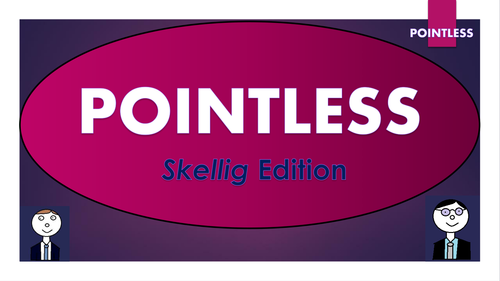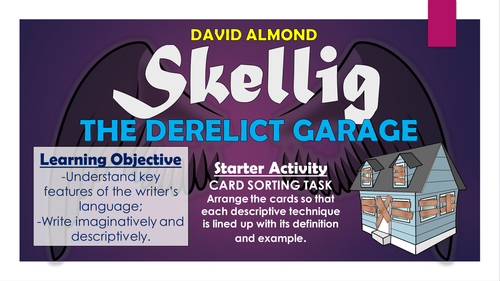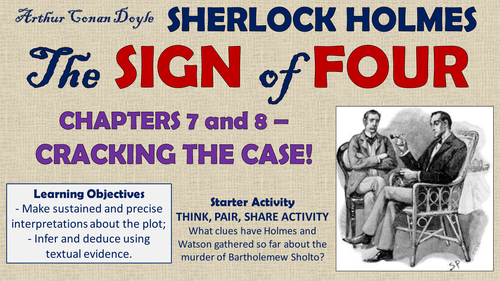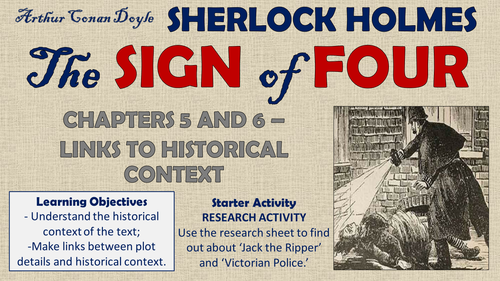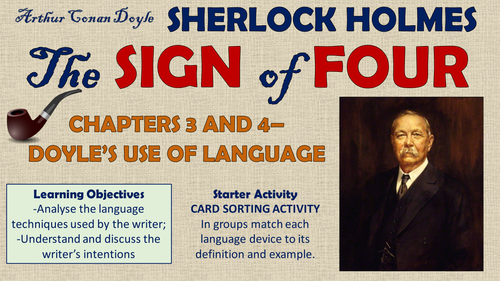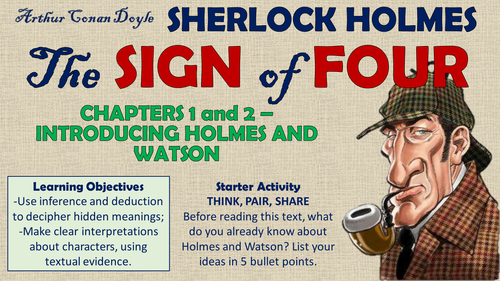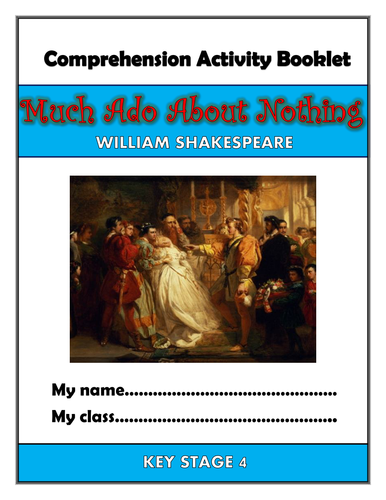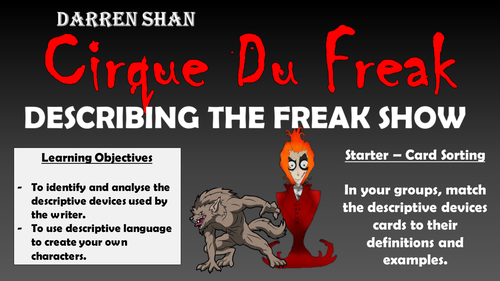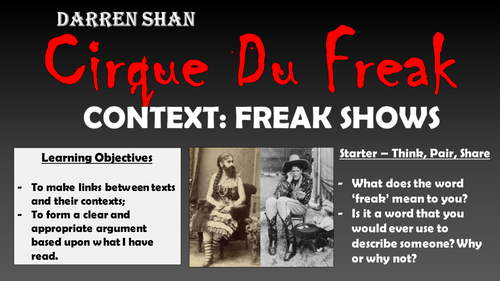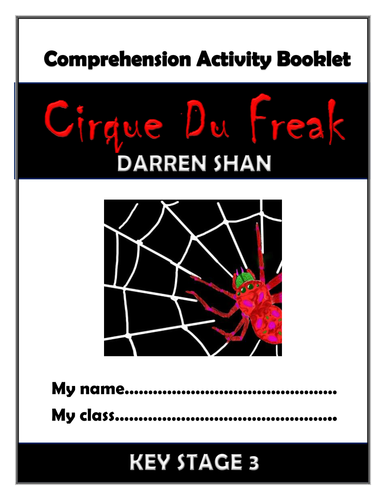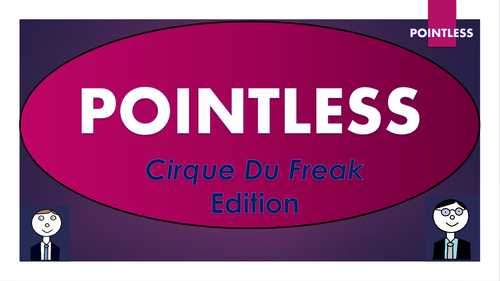
3k+Uploads
1951k+Views
2269k+Downloads
Languages

Skellig Pointless Game!
Based on the popular game show 'Pointless', this resource is perfect for use as a whole lesson resource, enrichment option, or revision tool. Editable, so that you can change to any other topic or change questions. (I've also added a blank template so that you can make your own games from scratch). Containing almost 30 slides of sound clips, interesting tasks, and suitably challenging questions, this resource is effective at both promoting engagement and enhancing learning. There are several full rounds of questions to build or revisit knowledge of characters, plot, and themes in 'Skellig.'
Round 1. The characters in Skellig
Round 2. Quotations from the text
Round 3. Settings and Objects
Round 4. Themes in Skellig
The nature of this game ensures that the resource can challenge students of all levels.
A blank template has also been added, so that you can create your own games!

Skellig - The Derelict Garage!
This engaging and informative lesson helps students to identify and analyse the descriptive language techniques used by David Almond to describe the derelict garage in Skellig, before creating their own descriptive language techniques to describe an old and run-down setting.
The lesson follows a step-by-step learning journey, in which children learn through:
- Defining and exemplifying the key descriptive techniques through a group activity;
- Reading and comprehending an extract from Skellig, in which Michael's old and run-down garage is described;
- Identifying the descriptive techniques within the extract and analysing their effectiveness;
- Learning how to create effective and imaginative adjectives, verbs, similes, metaphors, and personification;
- Creating their own device-filled descriptions of an old and decrepit place;
- Peer assessing each other's learning attempts;
Included is:
- Whole lesson PowerPoint - colourful and comprehensive;
- Word Bank template (pdf and word);
- Selected extract - Skellig - Michael's Garage;
- 'Create Your Own Personification' worksheet (pdf and word);
- Cards for the card-sorting activity;
- Comprehensive lesson plan.
There are also opportunities for group learning, speaking and listening, peer assessment, and whole class discussion. I originally used these resources with a year 7 class, however colleagues have used them for between years 4 and 9 with minimal adaptations.
All images are licensed for commercial use, and image rights are listed on the last page of the presentation.
Bundle Sale

The Sign of Four Huge Bundle!
THIS BUNDLE CONTAINS ALL OF THE 'THE SIGN OF FOUR' LESSONS, IN ADDITION TO THE 30-PAGE COMPREHENSION BOOKLET, THE KNOWLEDGE ORGANISER AND THE POINTLESS GAME!
This engaging, varied, and informative scheme of learning is designed to help students gain understanding, assessment skills, and key interpretations of Arthur Conan Doyle's 'The Sign of Four.' Made up of a wide-range of interesting and exciting lessons, students should complete this scheme having gathered vital skills in: interpreting the significant meanings of the text, understanding the writer's ideas within the text, analysing key characters, settings, and themes, and understanding Doyle's language devices.
Stimulating, visual, and easily adaptable, these lessons provide suggested learning objectives and outcomes for students of a wide-range of abilities - The vast majority of tasks are differentiated to allow for different abilities and needs in your classroom. Each lesson loosely follows this logical learning journey to ensure that students learn in bite-size steps:
- Engaging
- Defining/ Understanding
- Identifying/Remembering
- Analysing/ Creating
- Peer or self evaluating.
All of the lessons are interactive, employ a variety of different teaching and learning methods and styles, and are visually-engaging. Resources, worksheets, and lesson plans are all provided.

The Sign of Four Comprehension Activities Booklet!
This resource booklet contains a wide range of age-appropriate, engaging, and meaningful comprehension activities for use throughout the reading of Arthur Conan Doyle's 'The Sign of Four.' Teachers have found them particularly useful in exam revision, comprehension tasks, or guided reading sessions. They are perfect for aiding the progress of students towards meeting the KS4 expectations within the new National Curriculum framework - this makes the tasks suitable for all examining bodies. Students have found these resources extremely engaging, and for teachers there is explicit information within each task regarding which comprehension strands the task is designed to demonstrate. They also relate to key extracts, characters, and themes from the story, ensuring that students gain a deep understanding of the text.
Activities within the booklet include:
- 'Context: 19th Century London' - to aid students with 'Drawing on knowledge of the purpose, audience and context of the writing, including its social, historical and cultural context and the literary tradition to which it belongs, to inform evaluation;'
- 'Doyle's Description' - to aid students with 'Analysing a writer’s choice of vocabulary, form, grammatical and structural features, and evaluating their effectiveness and impact;'
- 'Mary Morstan' - to aid students with 'Seeking evidence in the text to support a point of view, including justifying inferences with evidence;'
- 'Editing the Text' - to aid students with 'Making an informed personal response, recognising that other responses to a text are possible and evaluating these.'
Plus many, many more activities (the booklet is around 30 pages in length!) I've also added it as a PDF in case the formatting differs on your computer.
All images are licensed for commercial use, and are cited on a separate document (included).
Bundle Sale

The Sign of Four Lesson Bundle!
This engaging, varied, and informative scheme of learning is designed to help students gain understanding, assessment skills, and key interpretations of Arthur Conan Doyle’s ‘The Sign of Four.’ Made up of a wide-range of interesting and exciting lessons, students should complete this scheme having gathered vital skills in: interpreting the significant meanings of the text, understanding the writer’s ideas within the text, analysing key characters, settings, and themes, and understanding Doyle’s language devices.
Stimulating, visual, and easily adaptable, these lessons provide suggested learning objectives and outcomes for students of a wide-range of abilities - The vast majority of tasks are differentiated to allow for different abilities and needs in your classroom. Each lesson loosely follows this logical learning journey to ensure that students learn in bite-size steps:
- Engaging
- Defining/ Understanding
- Identifying/Remembering
- Analysing/ Creating
- Peer or self evaluating.
All of the lessons are interactive, employ a variety of different teaching and learning methods and styles, and are visually-engaging. Resources, worksheets, and lesson plans are all provided.

The Sign of Four - Tonga!
In this engaging and informative lesson, students learn to make sustained and precise interpretations of the character of Tonga in 'The Sign of Four.' In particular, students analyse Watson’s account of Tonga’s appearance, mannerisms and behaviours in chapter 10 of the novel, before linking this to notions of the savage cultural ‘other’ that were commonly held during the colonial era in Britain.
The lesson follows a step-by-step learning journey, in which students learn through:
- Understanding the social and cultural context of Britain's colonial past;
- Reading and understanding chapters 9 and 10, in which Tonga makes his appearance;
- Identifying and analysing the language techniques used by Doyle in describing Tonga;
- Understanding how readers at the time would react to the depiction of Tonga;
- Peer assessing each other's learning attempts.
Included is:
- Whole Lesson PowerPoint - colourful and comprehensive;
- Paper Copies of Chapters 9 and 10;
- Tonga - Links to Context Worksheet (and teacher answer sheet);
- Essay Template;
- Detailed Lesson Plan
There are also opportunities for group learning, peer assessment, and whole class discussion. These resources were originally taught to GCSE students, but with subtle adaptations they have also been used with both younger and older (up to A Level) students.
Please note that you'll need access to internet/laptops for opening quiz activity.
All images are licensed for commercial use, and image rights are listed on the last page of the presentation.

The Sign of Four - Cracking the Case!
In this engaging and informative lesson enables students to make clear and insightful links between Arthur Conan Doyle’s 'The Sign of Four' and its historical context of 19th Century London. In particular, students learn about the Jack the Ripper murders and subsequent attitudes towards the police, before considering how these ideas are reflected through Athelney Jones in the novel.
The lesson follows a step-by-step learning journey, in which students learn through:
- Researching the context of 19th Century London, such as the Jack the Ripper murders and attitudes towards the police;
- Reading and understanding chapters 5 and 6, in which Athelney Jones makes his appearance;
- Identifying and analysing the language techniques used by Doyle in describing Athelney Jones;
- Analysing Doyle's intentions in presenting Athelney Jones in such a manner;
- Peer assessing each other's learning attempts.
Included is:
- Whole Lesson PowerPoint - colourful and comprehensive;
- Paper Copies of Chapters 5 and 6;
- Athelney Jones links to context worksheet;
- Researching Context worksheet
- Essay Template;
- Detailed Lesson Plan
There are also opportunities for group learning, peer assessment, and whole class discussion. These resources were originally taught to GCSE students, but with subtle adaptations they have also been used with both younger and older (up to A Level) students.
Please note that you'll need access to internet/laptops for the researching activity.
All images are licensed for commercial use, and image rights are listed on the last page of the presentation.

The Sign of Four - Links to Historical Context!
In this engaging and informative lesson enables students to make clear and insightful links between Arthur Conan Doyle’s 'The Sign of Four' and its historical context of 19th Century London. In particular, students learn about the Jack the Ripper murders and subsequent attitudes towards the police, before considering how these ideas are reflected through Athelney Jones in the novel.
The lesson follows a step-by-step learning journey, in which students learn through:
- Researching the context of 19th Century London, such as the Jack the Ripper murders and attitudes towards the police;
- Reading and understanding chapters 5 and 6, in which Athelney Jones makes his appearance;
- Identifying and analysing the language techniques used by Doyle in describing Athelney Jones;
- Analysing Doyle's intentions in presenting Athelney Jones in such a manner;
- Peer assessing each other's learning attempts.
Included is:
- Whole Lesson PowerPoint - colourful and comprehensive;
- Paper Copies of Chapters 5 and 6;
- Athelney Jones links to context worksheet;
- Researching Context worksheet
- Essay Template;
- Detailed Lesson Plan
There are also opportunities for group learning, peer assessment, and whole class discussion. These resources were originally taught to GCSE students, but with subtle adaptations they have also been used with both younger and older (up to A Level) students.
Please note that you'll need access to internet/laptops for the researching activity.
All images are licensed for commercial use, and image rights are listed on the last page of the presentation.

The Sign of Four Pointless Game!
Based on the popular game show 'Pointless', this resource is perfect for use as a whole lesson resource, enrichment option, or revision tool. Editable, so that you can change to any other topic or change questions. (I've also added a blank template so that you can make your own games from scratch). Containing almost 30 slides of sound clips, interesting tasks, and suitably challenging questions, this resource is effective at both promoting engagement and enhancing learning. There are several full rounds of questions to build or revisit knowledge of characters, plot, and themes in Arthur Conan Doyle's 'The Sign of Four.'
Round 1. The characters in The Sign of Four
Round 2. Quotations from the text
Round 3. Settings and Objects
Round 4. Themes in The Sign of Four
The nature of this game ensures that the resource can challenge students of all levels.
A blank template has also been added, so that you can create your own games!

The Sign of Four - Doyle's Use of Language
In this engaging and informative lesson, students make clear and insightful interpretations of Arthur Conan Doyle’s use of language throughout 'The Sign of Four.' In particular, students analyse how Doyle uses metaphor, alliteration and pathetic fallacy to describe the journey Holmes and Watson take across the dreary streets of London in Chapter 3.
The lesson follows a step-by-step learning journey, in which students learn through:
- Define and exemplify a range of language devices, including pathetic fallacy;
- Reading and understanding chapters 3 and 4, in which Holmes, Watson, and Miss Marston travel across London to meet Mr Thaddeus Sholto;
- Identifying and analysing the language techniques used by Doyle in describing the London streets;
- Analysing Doyle's intentions in using each of the language features, and considering the effect that these have upon the reader;
- Peer assessing each other's learning attempts.
Included is:
- Whole Lesson PowerPoint - colourful and comprehensive;
- Paper Copies of Chapters 3 and 4;
- Cards for the Card-Sorting Activity;
- Language Techniques Worksheet (and Teacher Answer Sheet);
- Essay Template;
- Detailed Lesson Plan
There are also opportunities for group learning, peer assessment, and whole class discussion. These resources were originally taught to GCSE students, but with subtle adaptations they have also been used with both younger and older (up to A Level) students.
All images are licensed for commercial use, and image rights are listed on the last page of the presentation.

The Sign of Four - Holmes and Watson
In this engaging and informative lesson, students make clear and insightful interpretations of Sherlock Holmes and Dr Watson – the chief protagonists in Arthur Conan Doyle’s 'The Sign of Four.' In particular, students learn about their key characteristics, mannerisms, appearance, and interactions of others – and relate these to ideas of societal expectations of the time.
The lesson follows a step-by-step learning journey, in which students learn through:
- Inferring and deducing what the novel may be about, from clues in the title;
- Reading and understanding chapters 1 and 2, and demonstrating understanding through answers to comprehension questions;
- Establishing the key character traits of Holmes and Watson, including their appearance, mannerisms and personality, using precise and relevant textual evidence;
- Analysing how each character is presented in the opening two chapters;
- Peer assessing each other's learning attempts.
Included is:
- Whole Lesson PowerPoint - colourful and comprehensive;
- Paper Copies of Chapters 1 and 2;
- Holmes Character Profile (and PDF);
- Watson Character Profile (and PDF);
- Essay Template;
- Detailed Lesson Plan
There are also opportunities for group learning, peer assessment, and whole class discussion. These resources were originally taught to GCSE students, but with subtle adaptations they have also been used with both younger and older (up to A Level) students.
All images are licensed for commercial use, and image rights are listed on the last page of the presentation.

Much Ado About Nothing KS4 Comprehension Activities Booklet!
This resource booklet contains a wide range of age-appropriate, engaging, and meaningful comprehension activities for use throughout the reading of William Shakespeare's 'Much Ado About Nothing.' Teachers have found them particularly useful in exam revision, comprehension tasks, or guided reading sessions. They are perfect for aiding the progress of students towards meeting the KS4 expectations within the new National Curriculum framework - this makes the tasks suitable for all examining bodies. Students have found these resources extremely engaging, and for teachers there is explicit information within each task regarding which comprehension strands the task is designed to demonstrate. They also relate to key extracts, characters, and themes from the play ensuring that students gain a deep understanding of the text.
Activities within the booklet include:
- 'Context: Shakespearean Times' - to aid students with 'Drawing on knowledge of the purpose, audience and context of the writing, including its social, historical and cultural context and the literary tradition to which it belongs, to inform evaluation;'
- 'Shakespeare's Description' - to aid students with 'Analysing a writer’s choice of vocabulary, form, grammatical and structural features, and evaluating their effectiveness and impact;'
- 'Friar Francis' - to aid students with 'Seeking evidence in the text to support a point of view, including justifying inferences with evidence;'
- 'Editing the Play' - to aid students with 'Making an informed personal response, recognising that other responses to a text are possible and evaluating these.'
Plus many, many more activities (the booklet is around 30 pages in length!) I've also added it as a PDF in case the formatting differs on your computer.
All images are licensed for commercial use, and are cited on a separate document (included).
Bundle Sale

Cirque Du Freak Lesson Bundle!
These engaging, varied, and informative lessons have been designed to help students gain a valuable understanding of the plot, characters, language, and key messages in Darren Shan’s ‘Cirque Du Freak.’
All of the resources that you need to teach are included in the bundle: Whole lesson step-by-step PowerPoint presentations, informative and engaging , worksheets, activities, and lesson plans.
Contained in the bundle are lessons based on:
- 1. The Introduction;
- 2. Context: Freak Shows;
- 3. Describing the Freak Show;
- 4. Steve Leonard
Stimulating, visual, and easily adaptable, these lessons provide suggested learning objectives and outcomes for students of a wide-range of abilities - The vast majority of tasks are differentiated to allow for different abilities and needs in your classroom. Each lesson loosely follows this logical learning journey to ensure that students learn in bite-size steps:
- Engaging
- Defining/ Understanding
- Identifying/Remembering
- Analysing/ Creating
- Peer or self evaluating.
All of the lessons are interactive, employ a variety of different teaching and learning methods and styles, and are visually-engaging.
Bundle Sale

Cirque Du Freak Huge Bundle!
THIS BUNDLE CONTAINS ALL OF THE CIRQUE DU FREAK LESSONS, IN ADDITION TO THE COMPREHENSION BOOKLET AND THE POINTLESS GAME!
This engaging, varied, and informative scheme of learning is designed to help students gain understanding, assessment skills, and key interpretations of Darren Shan’s ‘Cirque Du Freak.’ Made up of a wide-range of interesting and exciting lessons, students should complete this scheme having gathered vital skills in: interpreting the significant meanings of the text, understanding the writer’s ideas within the text, identifying the traits of key characters, settings, and themes, and understanding language devices.
Stimulating, visual, and easily adaptable, these lessons provide suggested learning objectives and outcomes for students of a wide-range of abilities - The vast majority of tasks are differentiated to allow for different abilities and needs in your classroom. Each lesson loosely follows this logical learning journey to ensure that students learn in bite-size steps:
- Engaging
- Defining/ Understanding
- Identifying/Remembering
- Analysing/ Creating
- Peer or self evaluating.
All of the lessons are interactive, employ a variety of different teaching and learning methods and styles, and are visually-engaging. Resources, worksheets, and lesson plans are all provided.

Cirque Du Freak - Steve Leonard!
This engaging and informative lesson helps students to understand and analyse how the character of Steve Leonard is introduced and developed throughout Darren Shan’s ‘Cirque Du Freak.’ In addition to considering how Shan uses foreshadowing in his introduction, students plot how Steve’s character develops as the events of the plot take place.
The lesson follows a step-by-step learning journey, in which children learn through:
- Reading and comprehending the opening chapters, understanding how Steve's character is initially presented to the reader;
- Defining the key term 'foreshadowing', and considering how this technique has been used by Shan in his introduction of Steve;
- Tracking the changes in Steve's character throughout the text;
- Analysing the characterisation of Steve throughout the text, utilising textual evidence to back up ideas;
- Peer assessing each other's learning attempts;
Included is:
- Whole lesson PowerPoint - colourful and comprehensive;
- Extracts from 'Cirque Du Freak' - Chapters 1-2;
- Analysing Steve's Character Essay Template;
- Character Development Graph Template;
- Detailed Lesson Plan.
There are also opportunities for group learning, speaking and listening, peer assessment, and whole class discussion. I originally used these resources with year 7 and 8 classes, however colleagues have used them for between years 4 and 9 with minimal adaptations.
All images are licensed for commercial use, and image rights are listed on the last page of the presentation.

Cirque Du Freak - Describing the Freak Show!
This engaging and informative lesson helps students to identify and analyse the descriptive devices used by Darren Shan throughout the description of the freak show in ‘Cirque Du Freak.’ In addition to interpreting and discussing the similes, metaphors, varied vocabulary, and alliteration used by the writer, students imaginatively use these devices themselves to create their own act for the Cirque Du Freak!
The lesson follows a step-by-step learning journey, in which children learn through:
- Defining each of the different types of descriptive devices, through completing an interactive group activity;
- Reading extracts from chapters 10-13, and identifying the language techniques used by Darren Shan to describe the freak show acts;
- Analysing the effectiveness of each of Darren Shan's descriptive devices;
- Creating their own act for the Cirque Du Freak, utilising appropriate and effective descriptive devices throughout;
- Peer assessing each other's learning attempts;
Included is:
- Whole lesson PowerPoint - colourful and comprehensive;
- Cards for the Card Sorting Activity;'
- Extracts from 'Cirque Du Freak' - Chapters 10 to 13 - the freak show;
- Analysing Language Devices worksheet;
- Character Profiles Template (in Word and PDF);
- Your Own Act Template (in Word and PDF).
There are also opportunities for group learning, speaking and listening, peer assessment, and whole class discussion. I originally used these resources with year 7 and 8 classes, however colleagues have used them for between years 4 and 9 with minimal adaptations.
All images are licensed for commercial use, and image rights are listed on the last page of the presentation.

Cirque Du Freak - Context: Freak Shows!
This engaging and informative lesson helps students to understand the social and historical context of ‘freak shows’ in order to aid their reading of Darren Shan’s ‘Cirque Du Freak.’ Students gather knowledge about when, where, and how freak shows operated, and apply this understanding to the text. They then form and write their own arguments regarding whether they believe freak shows should be allowed. There are easily enough resources for 2-3 lessons here.
The lesson follows a step-by-step learning journey, in which children learn through:
- Reading and understanding information about the history of freak shows;
- Answering comprehension questions and creating a timeline to demonstrate their understanding;
- Reading selected extracts from the text, in order to link ideas regarding context and text together;
- Forming and writing a fair and balanced argument, using a model example and a helpsheet, about whether they think freak shows should be legal;
- Peer assessing each other's learning attempts;
Included is:
- Whole lesson PowerPoint - colourful and comprehensive;
- Information Text - Freak Shows
- Extract from 'Cirque Du Freak' - Chapters 2 and 8;
- Timeline Template;
- Balanced Argument Worksheet;
- Writing to Argue Help-sheet
- Comprehensive lesson plan.
There are also opportunities for group learning, speaking and listening, peer assessment, and whole class discussion. I originally used these resources with year 7 and 8 classes, however colleagues have used them for between years 4 and 9 with minimal adaptations.
All images are licensed for commercial use, and image rights are listed on the last page of the presentation.

Cirque Du Freak Comprehension Activities Booklet!
This resource booklet contains a wide range of age-appropriate, engaging, and meaningful comprehension activities for use throughout the reading of Darren Shan's 'Cirque Du Freak.' Teachers have found them particularly useful in comprehension or guided reading sessions. They are perfect for aiding the progress of children towards meeting the KS3 expectations within the new National Curriculum framework. Children have found these resources extremely engaging, and for teachers there is explicit information within each task regarding which comprehension strands the task is designed to demonstrate. They also relate to key extracts, characters, and themes from the story, ensuring that children gain a deep understanding of the text.
Activities within the booklet include:
- 'Context: Freak Shows' - to enable students to demonstrate that they can: 'Know the purpose, audience and context of the writing and drawing on this knowledge to support comprehension.'
- 'Shan's Description of Truska' - to enable students to demonstrate that they can: 'Know how language, including figurative language, vocabulary choice, grammar, text structure and organisational features, present meaning.'
- 'Mr Crepsley' and 'Rhamus Twobellies' - to enable students to demonstrate that they can: 'Study setting, plot, and characterisation, and the effects of these.'
- 'Vocabulary Inspector' - to enable students to demonstrate that they can: 'Learn new vocabulary, relating it explicitly to known vocabulary and understanding it with the help of context and dictionaries.'
Plus many, many more activities (the booklet is 21 pages in length!) I've also added it as a PDF in case the formatting differs on your computer.
All images are licensed for commercial use, and are cited on a separate document (included).

Cirque Du Freak Pointless Game! (and template to create your own games!)
Based on the popular game show 'Pointless', this resource is perfect for use as a whole lesson resource, enrichment option, or revision tool. Editable, so that you can change to any other topic or change questions. (I've also added a blank template so that you can make your own games from scratch). Containing almost 30 slides of sound clips, interesting tasks, and suitably challenging questions, this resource is effective at both promoting engagement and enhancing learning. There are several full rounds of questions to build or revisit knowledge of characters, plot, and themes in 'Cirque Du Freak.'
Round 1. The characters in Cirque Du Freak
Round 2. Quotations from the text
Round 3. Settings and Objects
Round 4. Themes in Cirque Du Freak
The nature of this game ensures that the resource can challenge students of all levels.
A blank template has also been added, so that you can create your own games!

Cirque Du Freak - The Introduction!
This engaging and informative lesson helps students to infer and deduce the hidden meanings in the introduction section of Darren Shan’s ‘Cirque Du Freak.’ Students act as ‘Text Detectives’ reading between the lines to find out deeper meanings in the introduction, using this information to make predictions about what may happen in the text.
The lesson follows a step-by-step learning journey, in which children learn through:
- Understanding why individual subject content was chosen for the introduction (e.g. the fear that spiders can arouse in many people);
- Reading the introduction, and answering comprehension questions to demonstrate their understanding;
- Functioning as 'Text Detectives', inferring and deducing the hidden meanings about narrator and plot that are provided within the introduction;
- Using inferences from textual evidence to make insightful and evidence-based predictions about the story;
- Peer assessing each other's learning attempts;
Included is:
- Whole lesson PowerPoint - colourful and comprehensive;
- Newspaper Article - 'The shape of fear - why spiders scare us so much;'
- Extract from 'Cirque Du Freak' - The Introduction;
- Text Detectives worksheet (and teacher model answer sheet);
- Comprehensive lesson plan.
There are also opportunities for group learning, speaking and listening, peer assessment, and whole class discussion. I originally used these resources with year 7 and 8 classes, however colleagues have used them for between years 4 and 9 with minimal adaptations.
All images are licensed for commercial use, and image rights are listed on the last page of the presentation.

